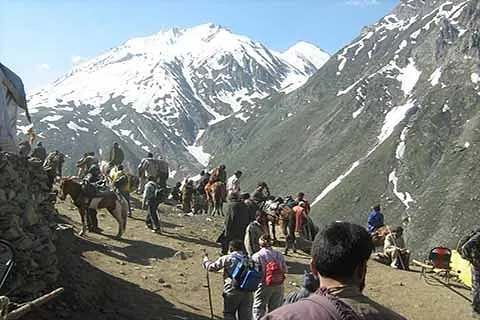On the directions of Governor Satya Pal Malik, the Chief Executive Officer of Amarnath Shrine Board, Umang Narula, took a meeting today to review arrangements to be made for providing rescue facilities in case of any emergent situation during the forthcoming Yatra.
Narula informed the Governor that a total of 27 Rescue Teamswill be deployed during the forthcoming Yatra. These teams would be drawn frompersonnel of J&K Armed Police, SDRF and the NDRF and equipped with allrescue equipment including Oxygen Cylinders.
At least 11 Mountain Rescue Teams (two more than last year)from the J&K Armed Police will be deployed to help women and sick Yatris innegotiating difficult stretches on the Yatra routes.
The meeting was informed that a total of 12 Avalanche RescueTeams – 11 teams of State Disaster Response Force and one team of CRPF – wouldbe deployed along both the routes.
Of these, seven teams would be deployed along Pahalgam routeat Chandanwari, Pissu Top, Zojibal-Nagakoti, Sheshnag, MG Top, Panjtarni andHoly Cave and five teams would be deployed along the Baltal route at Baltal,Domel, Railpatri, Brarimarg and Sangam Top.
Besides, four Search and Rescue teams of National DisasterResponse Force (NDRF) are also being deployed at Pahalgam, Chandanwari,Sheshnag, Panjtarni and Baltal.
The rescue teams equipped with necessary paraphernalia shallbe deployed at critical stretches, particularly between Railpathri andBrarimarg, forewarning Yatris about shooting stones and landslides.
It was decided that effective strength of rescue teams wouldbe increased from 10 to 15 and SSPs of Ganderbal and Anantnag districts shallfix RD wise jurisdiction of rescue teams.
It was also decided to introduce Common Access Protocol(CAP) in the Yatra area, linked with Emergency Operation Centres (EOCs) atSonamarg and Chandanwari, to enable all Yatris and others present in that grid to receive SMSs in caseof emergent situations on any network.
This would be in addition to Priority Call Routing (PCR) portalwhich will help to prioritize the calls of officers associated with disastermanagement, even if there is congestion in the communication network.






